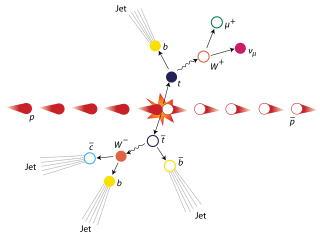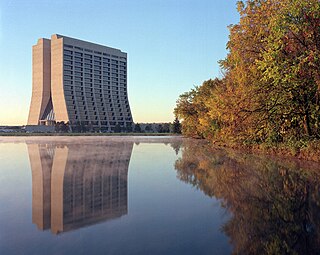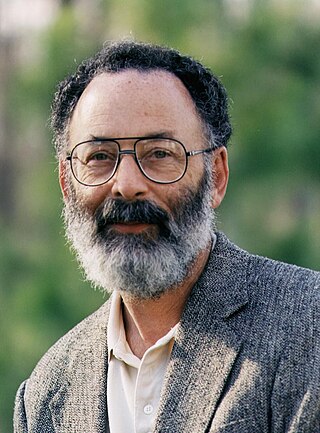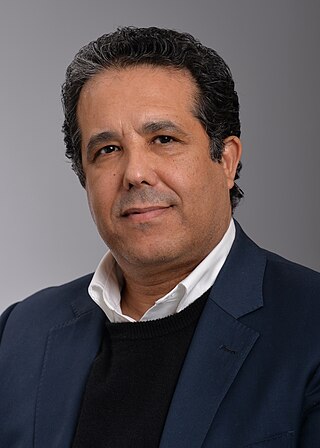
Leon Max Lederman was an American experimental physicist who received the Nobel Prize in Physics in 1988, along with Melvin Schwartz and Jack Steinberger, for research on neutrinos. He also received the Wolf Prize in Physics in 1982, along with Martin Lewis Perl, for research on quarks and leptons. Lederman was director emeritus of Fermi National Accelerator Laboratory (Fermilab) in Batavia, Illinois. He founded the Illinois Mathematics and Science Academy, in Aurora, Illinois in 1986, where he was resident scholar emeritus from 2012 until his death in 2018.

Particle physics or high-energy physics is the study of fundamental particles and forces that constitute matter and radiation. The field also studies combinations of elementary particles up to the scale of protons and neutrons, while the study of combination of protons and neutrons is called nuclear physics.

Fermi National Accelerator Laboratory (Fermilab), located in Batavia, Illinois, near Chicago, is a United States Department of Energy national laboratory specializing in high-energy particle physics. Since 2007, Fermilab has been operated by the Fermi Research Alliance (FRA), a joint venture of the University of Chicago, and the Universities Research Association (URA); although in 2023, the Department of Energy (DOE) opened bidding for a new contractor due to concerns about the FRA performance. Fermilab is a part of the Illinois Technology and Research Corridor.

The antiproton,
p
, is the antiparticle of the proton. Antiprotons are stable, but they are typically short-lived, since any collision with a proton will cause both particles to be annihilated in a burst of energy.

The Tevatron was a circular particle accelerator in the United States, at the Fermi National Accelerator Laboratory, east of Batavia, Illinois, and was the highest energy particle collider until the Large Hadron Collider (LHC) of the European Organization for Nuclear Research (CERN) was built near Geneva, Switzerland. The Tevatron was a synchrotron that accelerated protons and antiprotons in a 6.28 km (3.90 mi) circumference ring to energies of up to 1 TeV, hence its name. The Tevatron was completed in 1983 at a cost of $120 million and significant upgrade investments were made during its active years of 1983–2011.

The top quark, sometimes also referred to as the truth quark, is the most massive of all observed elementary particles. It derives its mass from its coupling to the Higgs Boson. This coupling is very close to unity; in the Standard Model of particle physics, it is the largest (strongest) coupling at the scale of the weak interactions and above. The top quark was discovered in 1995 by the CDF and DØ experiments at Fermilab.
In particle physics, the W and Z bosons are vector bosons that are together known as the weak bosons or more generally as the intermediate vector bosons. These elementary particles mediate the weak interaction; the respective symbols are
W+
,
W−
, and
Z0
. The
W±
bosons have either a positive or negative electric charge of 1 elementary charge and are each other's antiparticles. The
Z0
boson is electrically neutral and is its own antiparticle. The three particles each have a spin of 1. The
W±
bosons have a magnetic moment, but the
Z0
has none. All three of these particles are very short-lived, with a half-life of about 3×10−25 s. Their experimental discovery was pivotal in establishing what is now called the Standard Model of particle physics.

ATLAS is the largest general-purpose particle detector experiment at the Large Hadron Collider (LHC), a particle accelerator at CERN in Switzerland. The experiment is designed to take advantage of the unprecedented energy available at the LHC and observe phenomena that involve highly massive particles which were not observable using earlier lower-energy accelerators. ATLAS was one of the two LHC experiments involved in the discovery of the Higgs boson in July 2012. It was also designed to search for evidence of theories of particle physics beyond the Standard Model.

The UA1 experiment was a high-energy physics experiment that ran at CERN's Proton-Antiproton Collider, a modification of the one-beam Super Proton Synchrotron (SPS). The data was recorded between 1981 and 1990. The joint discovery of the W and Z bosons by this experiment and the UA2 experiment in 1983 led to the Nobel Prize for physics being awarded to Carlo Rubbia and Simon van der Meer in 1984. Peter Kalmus and John Dowell, from the UK groups working on the project, were jointly awarded the 1988 Rutherford Medal and Prize from the Institute of Physics for their outstanding roles in the discovery of the W and Z particles.

The Collider Detector at Fermilab (CDF) experimental collaboration studies high energy particle collisions from the Tevatron, the world's former highest-energy particle accelerator. The goal is to discover the identity and properties of the particles that make up the universe and to understand the forces and interactions between those particles.

The DØ experiment was a worldwide collaboration of scientists conducting research on the fundamental nature of matter. DØ was one of two major experiments located at the Tevatron Collider at Fermilab in Batavia, Illinois. The Tevatron was the world's highest-energy accelerator from 1983 until 2009, when its energy was surpassed by the Large Hadron Collider. The DØ experiment stopped taking data in 2011, when the Tevatron shut down, but data analysis is still ongoing. The DØ detector is preserved in Fermilab's DØ Assembly Building as part of a historical exhibit for public tours.

Nathan Isgur was a theoretical physicist from the U.S. and Canada.

Neutral B meson oscillations are one of the manifestations of the neutral particle oscillation, a fundamental prediction of the Standard Model of particle physics. It is the phenomenon of B mesons changing between their matter and antimatter forms before their decay. The
B
s meson can exist as either a bound state of a strange antiquark and a bottom quark, or a strange quark and bottom antiquark. The oscillations in the neutral B sector are analogous to the phenomena that produce long and short-lived neutral kaons.
George Randolph Kalbfleisch was an American particle physicist.

Nigel Stuart Lockyer is a British-American experimental particle physicist. He is the current director of the Cornell Laboratory for Accelerator-based ScienceS and Education (CLASSE) as of May 1, 2023. He was the Director of the Fermi National Accelerator Laboratory (Fermilab), in Batavia, Illinois, the leading particle physics laboratory in the United States, from September 2013 to April 2022.

Young-Kee Kim is a South Korea-born American physicist and Louis Block Distinguished Service Professor of Physics at the University of Chicago. She is chair of the Department of Physics at the university.
Paul Dutton Grannis is an American physicist.

Kevin T. Pitts is an American high energy particle physicist. In addition to his faculty appointment at the University of Illinois at Urbana–Champaign, in 2021 he was appointed chief research officer at Fermilab National Accelerator Laboratory. His research interests have included the CDF experiment and the Muon g-2 experiment at Fermilab.

Kamal Benslama is a Moroccan-Swiss experimental particle physicist. He is a professor of physics at Drew University, a visiting experimental scientist at Fermilab, and a guest scientist at Brookhaven National Laboratory. He worked on the ATLAS experiment, at the Large Hadron Collider (LHC) at CERN in Switzerland, which is considered the largest experiment in the history of physical science. At present, he is member of the MU2E collaboration at Fermi National Accelerator Laboratory (Fermilab), located just outside Batavia, Illinois, near Chicago. Fermilab is a United States Department of Energy national laboratory specializing in high-energy particle physics.
James Lewis Pinfold is a British-Canadian physicist, specializing in particle physics.

















